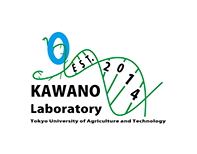WHAT's NEW
Jun. 16, 2021
A paper on "Single-cell RNA-seq analysis reveals penaeid shrimp hemocyte subpopulations and cell differentiation process" by Dr. Koiwai (TUMSAT) is now accepted in eLife!
Jun. 10, 2021
Usami-kun and Fujita-san gave a poster presentation at 7th Molecular Engine Meeting.
May 17-18, 2021
Dr. Kawano gave a lecture, and Liu-san, Takeuchi-san, Ji-kun, and Takagi-san gave a poster presentation at Cheminas43 (Online). Liu-san won Excellent Presentation Award!
May 13-14, 2021
Dr. Kawano gave an oral presentation, and Izumi-san and Fujita-san gave a poster presentation at 6th Molecular Engine Meeting.
Apr. 30, 2021
An Encyclopedia on “Reference Module in Biomedical Sciences, New Sensing Technologies: Microtas/NEMS/MEMS” by Dr. Yasuga (Ochanomizu Univ.), Dr. Shoji (Nagaoka Univ. of Tech.), Dr. Koiwai (TUMSAT) and Dr. Kawano is now published by Elsevier!
Mar. 26-29, 2021
Dr. Koiwai gave a lecture and poster presentation at The Japanese Society of Fisheries Science (Online).
Mar. 25, 2021
Master's degree (engineering) was awarded to Izumi-san, Takeuchi-san, Numaguchi-san, and Yamaji-san, and bachelor's degree (engineering) was awarded to Hayashi-kun, Fukuda-san, Mizoguchi-kun and Miyagi-san.
Mar. 22, 2021
A study about nanopore decoding for a Hamiltonian path problem by Takiguchi-kun was press released from TUAT.
Mar. 4-5, 2021
Dr. Kawano gave a lecture at Institute for Protein Research (IPR) of Osaka University (Online).
Mar. 1, 2021
A paper on "Nanopore Decoding for a Hamiltonian Path Problem" by Takiguchi-kun is now accepted in Nanoscale!
Mar. 1, 2021
Hayashi-kun, Fukuda-san, Mizoguchi-kun, Miyagi-san gave a presentation of Graduation thesis@TUAT.
Feb. 22-26, 2021
Liu-san gave a oral presentation at 65th Biophysical Society Annual Meeting.
Feb. 19, 2021
A book on "DNA-and RNA-Based Computing Systems, Chapter 17: Nanopore Decoding for DNA Computing" by Dr. Yasuga (Ochanomizu Univ.), Dr. Shoji (Nagaoka Univ. of Tech.), and Dr. Kawano is now published by Wiley.
Feb. 9, 2021
Izumi-san, Takeuchi-san and Numaguchi-san gave a presentation of master thesis@TUAT (Online).
Feb. 6, 2021
A paper on "Lipid bilayer on a microdroplet integrated with a patterned Ag/AgCl microelectrode for voltage-clamp fluorometry of membrane transport" by Dr. Kawano and
Tonooka Lab. (Kyoto Institute of Technology) is now accepted in Sensors and Actuators B: Chemical.
Feb. 6, 2021
Yamaji-san gave a presentation of master thesis@TUAT (Online).
Previously update
EVENTS
7. 13 Open Lab. for 3rd grade students
8. 11-12 TUAT summer open campus
8. 17-18 Graduate school entrance exam
10. 10-14 MicroTAS 2021
10. 20-22 The 58th Japanese Peptide Symposium
11. 9-11 Cheminas44
COPYRIGHT(c) 2014-2018 KAWANO Lab. All Rights Reserved.





